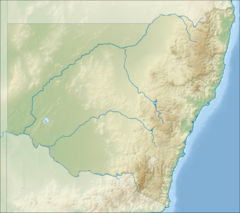Cape Byron Light

Cape Byron Light in 2006
|
|
| Location |
Cape Byron New South Wales Australia |
|---|---|
| Coordinates | 28°38′18.69″S 153°38′11.17″E / 28.6385250°S 153.6364361°ECoordinates: 28°38′18.69″S 153°38′11.17″E / 28.6385250°S 153.6364361°E |
| Year first constructed | 1901 |
| Construction | concrete blocks |
| Tower shape | cylindrical tower with balcony and lantern |
| Markings / pattern | white tower and lantern |
| Height | 74 feet (23 m) |
| Focal height | white: 387 feet (118 m) red: 364 feet (111 m) |
| Original lens | 1st order Henry-LePaute Fresnel lens |
| Light source | mains power |
| Intensity | 2,200,000 candela |
| Range | white: 27 nautical miles (50 km; 31 mi) red: 8 nautical miles (15 km; 9.2 mi) |
| Characteristic | Fl W 15s. F W |
| Admiralty number | K2838 |
| NGA number | 111-5884 |
| ARLHS number | AUS-025 |
| Managing agent | Australian Maritime Safety Authority |
|
[]
|
|
Cape Byron Light is an active lighthouse located at Cape Byron, New South Wales, Australia. It is Australia's most powerful lighthouse, with a light intensity of 2,200,000 cd. Cape Byron, the easternmost point of the mainland of Australia, is about 3 kilometres (1.9 mi) northeast of the town of Byron Bay.
Though Cape Byron was explored in the early 19th century, and construction of lighthouses on the New South Wales shore quickened in the mid 19th century, and especially in the 1870s under Colonial Architect James Barnet, a lighthouse was not constructed on the cape since it was considered clearly visible anyway. The decision to proceed with building the light was made at the end of the 1890s, and the site was levelled in October 1899.
The tower was built by James Barnet's successor, Charles Assinder Harding, who also designed Norah Head Light and Point Perpendicular Light, in a style similar to Barnet's.
Construction of the site began in July 1900 by contractors Mitchell and King. The total cost was £10,042 pounds to the contractors, £8,000 for the apparatus and lantern house, and £2,600 for the road from Byron Bay township. Adjusting for inflation, this equates to roughly $2.8M Australian dollars today.
Construction ended in 1901 and was to be celebrated on 30 November 1901 in a great banquet, with special trains carrying visitors from Lismore and Murwillumbah, at the presence of the Premier of the day, the Hon. John See, who was to arrive from Sydney in the government steamer 'Victoria'. However, bad weather delayed the ship till the following day and the banquet was held without him. The opening by the Premier took place a day later.
The lens now in use is the original 1st-order bivalve Henry-LePaute Fresnel lens. The 2 metres (6 ft 7 in) diameter lens, weighing 8 tonnes (7.9 long tons; 8.8 short tons), contains 760 pieces of highly polished prismatic glass, floating in a 7 long hundredweight (780 lb; 360 kg) float bath of mercury. It was the first lighthouse in Australia with a mercury float mechanism. The mechanism is rotating also during the day to reduce the risk of fire from the sun's rays. It is the only Henry-LePaute apparatus in Australis.
...
Wikipedia

